Ansó, 8 January 2017
by Isabel Isherwood - 15:34 on 08 January 2017
We’ve been back in Ansó a week now, after eleven days in the UK over Christmas and New Year. We’ve all found the new year surprisingly hard – for the girls it has been hard to come back here, where they are very aware that they are just a bit different and don’t quite fit in, after being so comfortable and happy at Granny and Grandpa’s house over Christmas. For Jake and I it has been the realisation that we have to make some decisions now about what happens next – summer doesn’t look so far away any more, from this side of Hogmanay.
However we are beating off the winter blues and our hermit-y tendencies with some days out exploring the area, and trying to spend time with other people.
The last three days we’ve been to three places we’ve not explored before, and they have all been fabulous – assisted of course by the fact that there has not been a cloud in the sky since we got back here. The nights are very cold – down to -8 most nights – but the sun in the daytime has real warmth in it provided there isn’t much wind.
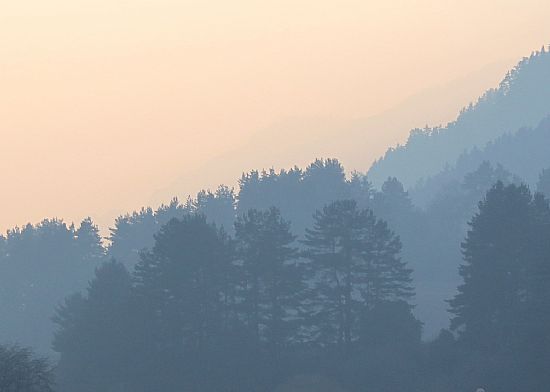
The first of our three trips was to Belagua in the Roncal Valley, the next major valley to the west of here across the border in the province of Navarra. For some reason we don’t seem to go over that way much, always tending to head east towards the bigger mountains. But Roncal is beautiful, and with quite a different ‘feel’ about it from Ansó and Hecho. At the head of the valley, in an amphitheatre of limestone cliffs is a broad, flat area of meadows and scattered farm buildings, turning to beech wood at the eastern side. A little refugio in the beechwoods offers a warm stove, coffee and hot chocolate; chips, fried eggs, and bacon baguettes; music, and sun streaming through the windows. Outside, the beech trees are majestically tall and straight. A forest track, transformed into a cathedral-like avenue by the form of the trees, leads away to the south with box bushes to either side. The entire forest floor is thickly carpeted with dry fallen leaves just asking to be swished through or thrown up in the air by the armful. The difference between this high straight-trunked forest and the twisted oaks and pines of the Ansó valley is striking. They feel so utterly unalike that it is hard to believe they are separated only by a ridge of hills.
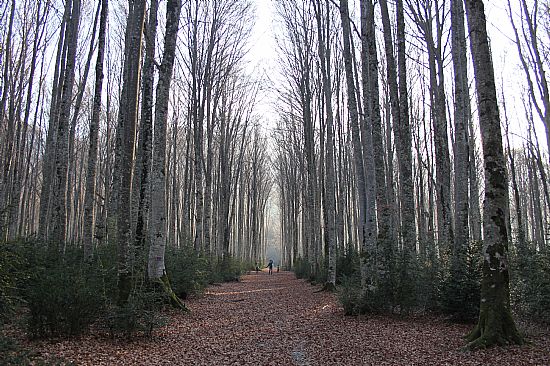
Our second trip was devised principally to give Rowan and Jake a destination for a bike ride. We picked the Roman bridge down the valley as it is a good ride away but has fairly manageable hills; Iona and I went down by car. The pool at the bridge (where Jake did his final outdoor swim of the year in early December) was frozen, and even the sections of faster flow were edged with heavy accretions of ice.
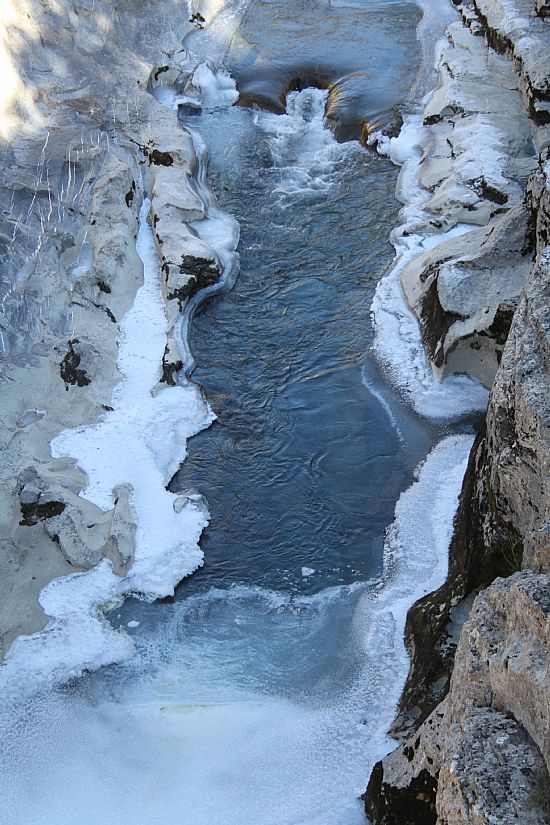
This time we took the path uphill on the other side, towards Borda del Lobo (Wolf farm/barn). The stream in the neighbouring valley is called Barranco o Lupe, and it seems likely that Lupe is Ansotano for wolf (we still need to check this out) – we loved walking through the sunlit woods imagining the time when wolves were still found in these hills. The path climbed, then contoured, then climbed again, quite faint in places but in others built up above or below with dry stone walls - evidently a ‘real’ path built with purpose long ago. We passed a sunny meadow and a scatter of ruined barns, climbed again, and suddenly arrived at a fork in the track and a lone signpost (the first we’d seen for the entire length of the walk); right was apparently the Camino de Santiago, or one of its many iterations which pass over the Pyrenees on the way from points in France and further afield to cpnverge finally on Santiago de Compostella in the far west of Galicia. Left was for the Cueva de Susei. We opted for the cave.
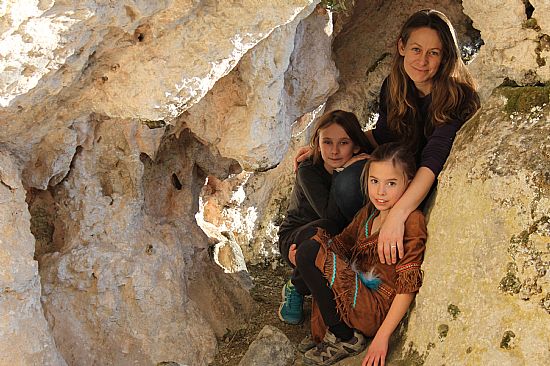
This was a wonderful discovery. Not exactly a cave, more of a place where a softer stratum of the rock had been scoured back to leave a deep and wide sheltered area protected by a substantial overhang. Water trickled and dripped in places, forming fat stalactites and stalagmites which in places had run together to form networks of walls and small cavelets. The whole space faced directly towards the afternoon sun, and was wonderfully warm. To complete my enjoyment of the place, I found a lovely badger sett making use of small natural caves under a broad limestone sill – the first sett I’ve found here, despite plenty of other signs and lots of searching.
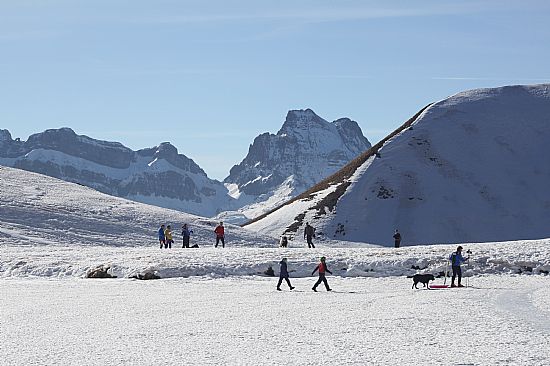
Our third trip was in search of snow. Everyone here is shaking their heads and tutting over the lack of precipitation, and although I can’t deny loving the sunshine, it is clear that the ground could use some water. It would also be great to have some real snow….. The Mayencos Club that Jake has joined announced they were planning a bike ride from Jaca up the valley to the ski station at Astún near the French border, then running from the end of the road up to a frozen mountain lake on which it would be possible to cross-country ski. Only three turned up for the ride, but another three planned to head up to the lake. The girls and I joined the non-cyclists. This was a group of people we didn’t know at all, and the girls were initially very subdued and inclined to be grumpy. But within minutes of starting the walk they had made friends with Lua the large black Labrador who was accompanying us, and were cheering up fast. They were a lovely and welcoming bunch, and very helpful with the children – but they are also a group of very fit outdoor types and they set off uphill at quite a pace; it felt fast for me, and took no account at all of smaller legs. To my astonishment, Iona and Rowan kept up with no complaint, and even though I could tell they were flagging a bit towards the top they just kept going. Rowan is a fast walker, but Iona usually lags behind, needs her inhaler, is hungry or thirsty or has problems with her feet….. On this occasion she went up the 400 m climb to the lake like a mountain goat.
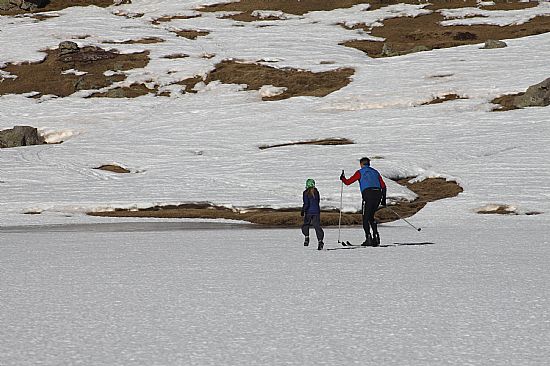
Up there it was like a little hidden world. The valley below had snow on the southern (north-facing) side, carefully maintained and extended to provide ski runs; but the north side, up which we’d climbed, was completely snow-free and positively warm in the sunshine. However the lake was in a shallow corrie which had somehow held onto its snow, and the lake itself was frozen solid – perfect for the skiers and also great for dog-sledding….. (Lua was strong and very amenable as well as just friendly!).
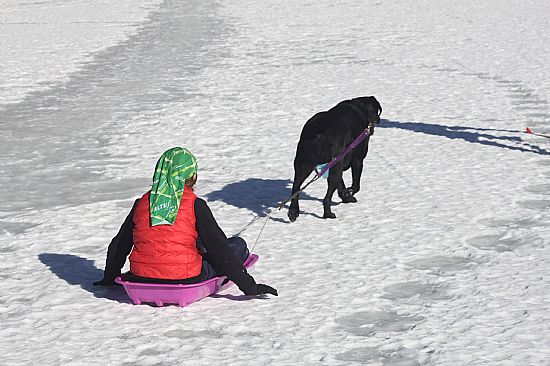
Add your comment